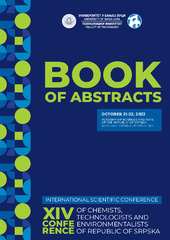Prikaz osnovnih podataka o dokumentu
Theoretical prediction of magnetic aminofunctionalized polymer sorbent performance using molecular modeling methods
| dc.creator | Suručić, Ljiljana T. | |
| dc.creator | Nastasović, Aleksandra | |
| dc.creator | Marković, Bojana | |
| dc.creator | Tadić, Tamara | |
| dc.creator | Onjia, Antonije | |
| dc.creator | Janjić, Goran | |
| dc.date.accessioned | 2024-01-12T07:40:18Z | |
| dc.date.available | 2024-01-12T07:40:18Z | |
| dc.date.issued | 2022 | |
| dc.identifier.isbn | 978-99938-54-96-8 | |
| dc.identifier.uri | http://TechnoRep.tmf.bg.ac.rs/handle/123456789/7083 | |
| dc.description.abstract | Improving the affinity and selectivity of polymeric materials for sorbing ionic species, particularly heavy metals that pose a high environmental risk, is crucial from an environmental standpoint. Research on the mechanism of sorption can aid in selecting the optimal sorbent for a given application. Sorption occurs as a result of various interactions. Sorption includes diffusion of ions through solution (typically the quickest), diffusion of ions through the boundary layer surrounding the sorbent surface, diffusion through the porous structure of the sorbent (intra-particle diffusion), and binding to active sites on sorbent surfaces. Kinetic and equilibrium models explain the sorption mechanism but not the nature of interactions, which is essential for predicting the selectivity and efficiency of the sorbent based on particular ionic species. As a result, we were compelled to approach the molecular level. Active sites on the surface of the magnetic aminofunctionalized polymer, which are amino functional groups, are used to bind ions to the magnetic nanocomposite. The sorption process can be viewed as the sum of ion-ligand unit interactions. Unit complex formation and stability can be studied with statistical analysis and quantum chemical calculations. The Cambridge database (CSD) improves the crystal structure of complex ion-ligand. Based on binding energy, DFT (Density Functional Theory) predicts the stability of complex molecules (unit ion-ligand interactions). To ensure an accurate calculation, it is essential to include all system parameters, including sorbent structure, ligand properties, ligand charge under specific conditions, ion forms and charges, and solvatation effects. In the early stages of research, defining the system's model lets researchers make theoretical predictions about the magnetic aminofunctionalized polymer sorbent's affinity and selectivity for certain ionic species. | sr |
| dc.language.iso | en | sr |
| dc.publisher | Banja Luka : University in Banjaluka, Faculty of Technology | sr |
| dc.rights | openAccess | sr |
| dc.rights.uri | https://creativecommons.org/licenses/by/4.0/ | |
| dc.source | Book of Abstracts / XIV Conference of Chemists, Technologists and Environmentalists of Republic of Srpska, Banja Luka, October 21-22, 2022 | sr |
| dc.subject | molecular modeling | sr |
| dc.subject | magnetic | sr |
| dc.subject | sorbent | sr |
| dc.subject | polymer | sr |
| dc.title | Theoretical prediction of magnetic aminofunctionalized polymer sorbent performance using molecular modeling methods | sr |
| dc.type | conferenceObject | sr |
| dc.rights.license | BY | sr |
| dc.citation.spage | 20 | |
| dc.identifier.fulltext | http://TechnoRep.tmf.bg.ac.rs/bitstream/id/19417/bitstream_19417.pdf | |
| dc.identifier.rcub | https://hdl.handle.net/21.15107/rcub_technorep_7083 | |
| dc.type.version | publishedVersion | sr |

